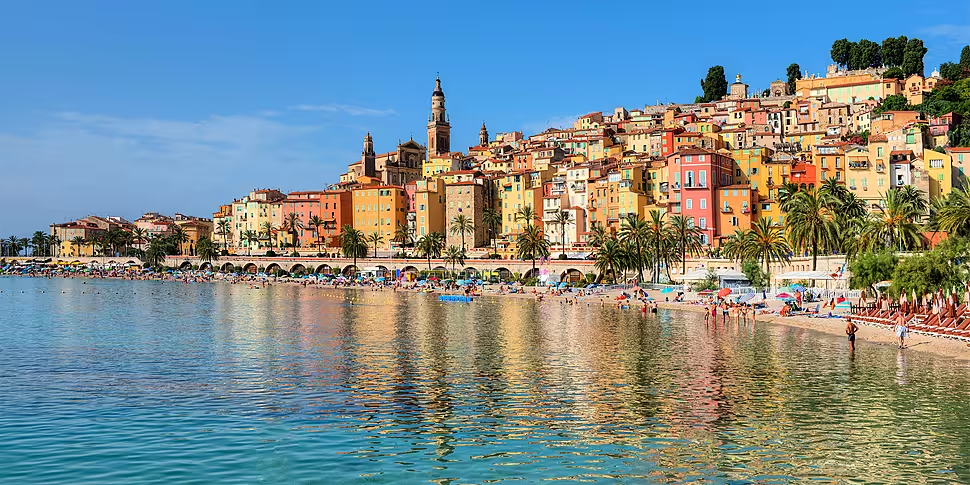Fionn Davenport joined Kieran Cuddihy on The Hard Shoulder for our final episode of Europe’s Hidden Highlights. This week he visits Menton, on the Cote d'Azur.
Menton
It’s the last town on the Cote d’Azur before you reach the Italian border.
A lovely old port surrounded by pastel mansions and shady streets – it’s a town reminiscent of the grand old days on the Riviera before it became over-developed and over-touristed.
There are plenty of beautiful towns along the Cote d’Azur, but Menton is one of those absolute gems that goes by unnoticed by most visitors.
Sights & Attractions
Most of the action takes place on and around pedestrianised rue St-Michel, which is full of ice cream parlours, cute boutiques and souvenir shops (it’s not very touristy, but it’s still touristy)
Cimitiere du vieux Chateau Strange to say that a cemetery is a city highlight, but the walk up to this hilltop spot is a beaut – along winding old lanes. William Webb Ellis is buried here, so this is something of a pilgrimage for rugby fans.
There are two museums dedicated to Jean Cocteau – the futuristic Musée Jean Cocteau Collection Séverin Wunderman, which has 1500 works by the artist donated by coll;ection Severin Wunderman in 2005. Unfortunately, it flooded last year and is unlikely to reopen until 2023.
But Cocteau fans can console themselves with a visit to Le Bastion, a 17th-century bastion on the seafront that Cocteau himself restored and transformed into a monument to his work. The pebble mosaics that cover much of it are all his.
There are also some nice gardens in the town – Jardin de la Serre de la Madone, Jardin Botanique Exotique (which has a vine-covered chateau)
Eating
There’s a fabulous food market near the seafront that is open until 1pm Tuesday to Sunday.
Just behind it, Maison Martin et Fils does delicious local specialties at a reasonable price – there’s a lunch menu for around €12-3.
For a blow-out meal, Le Mirazur (www.mirazur.fr) is all about design, sea views and outstanding cuisine, all set in a 1930s villa that in 2019 was named the best restaurant in the world. Oh, and it has three Michelin stars and the nine-course tasting menu costs €330 – and that doesn’t include wine.
The chef is Mauro Colagreco, and he runs cooking classes too. There are also – time permitting – visits with the chef to the incredible garden from which he gets all of his veg and herbs. It’s about 3km northeast of town on the coastal road to Italy.
Au Pays du Citron – Menton is known for its lemons, and here you can get all kinds of citrussy treats – limoncello, lemon-infused oil, lemon wine, lemon preserve…you get the picture.
Sleeping
Most elegant spot in town is the Hotel Napoleon (www.napoleon-menton.com), right on the seafront – a boutique hotel where doubles start at around €170. There’s a pool and a restaurant.
Day Trips
Italy. Go on, why not? You’re literally across the border from Ventimiglia. You can drive, or take the train, 10 minutes away. Friday is the best day to visit as it has an amazing all-day market that is very popular with locals. The French flock to it for its cheap fruit and veg, tasty deli counters (mozzarella-stuffed peppers, sun-dried tomatoes etc), bargain leather goods and cheap fashion. Watch out for counterfeits here; French customs take it very seriously and you risk a fine and confiscation of your goods.
Ste-Agnès’ claim to fame – Europe’s highest seaside village – is not for nothing: sitting snug on a rocky outcrop at 780m, the village looks spectacular and commands dramatic views of the area.
For the most breathtaking panorama, climb the 200 or so steps to the rubbly 12th-century château ruins with their intriguing flower beds, based on allegorical gardens found in medieval French poetry.
At one end of the village is a huge subterranean fort built as a protection in the years leading up to WWII. And it’s really thanks to the army that the village has remained intact, as all developments were prohibited as long as it was of strategic value. You can get a bus from the train station – it takes 45 minutes.
Roquebrune-Cap-Martin
Cap Martin is gorgeous. Jutting out into the sea just west of Menton, the cape is worth going to if only for the Cabanon Le Corbusier (www.capmoderne.com), a beach hut built by the French architect as his holiday home in 1952. The hut can be visited on excellent two-hour guided tours run by the Association Cap Moderne; tours depart on foot from Roquebrune-Cap-Martin train station and must be reserved in advance by email.
What first brought Le Corbusier here was his friend Eileen Gray, who lived here in the 1930s - During one of his stays, however, Le Corbusier decided to paint the interior of Gray’s villa without asking here. Gray was furious as the paintings ruined her own design, plus she was offended by the subject matter of women kissing (Gray was gay, and didn’t really appreciate Le Corbusier’s labouring the point).
Gray’s villa is Villa E-1027 (www.capmoderne.com) a tour de force of a Mediterranean villa, complete with highly inventive furniture and fixtures, in the late 1920s. Book the tour ahead as they only take limited numbers at any one time.
Above the cape is medieval village of Roquebrune, which is reached by a tortuous 45-minute walk up a set of steep steps. But the village is worth the effort, if only for the 10th-century chateau – walk up the (admittedly very steep) rue Moncollet, which has arcaded passages and rock-carved stairways.
Le Corbusier is buried in the village cemetery – section J, he designed the tombstone himself.
For the best views from the village, go to the place des Deux Freres.
Sentier du Littoral
Except for when you walk through Monaco, you can walk the 13km stretch of coastline between Roquebrune-Cap Martin and Cap d’Ail without passing a car.
Starting west of Menton, the Sentier du Littoral follows Cap Martin’s rugged coastline past beaches and wooded shores, including beautiful Plage Buse, all the way to Monaco’s Plage Larvotto. Resuming at Plage Marquet near Monaco's western edge, the path skirts dramatic coastal bluffs all the way to hedonistic Plage Mala in Cap d’Ail.











